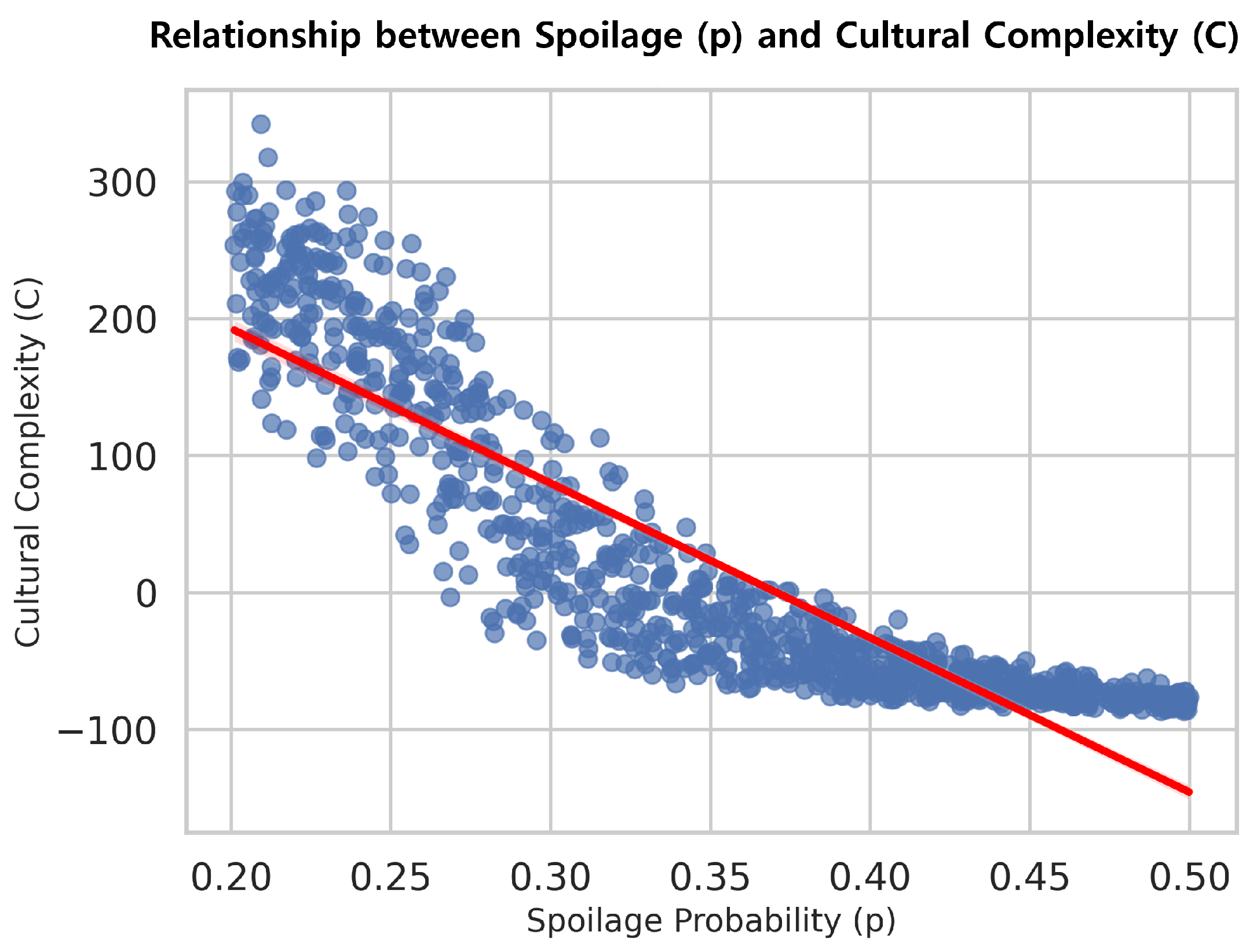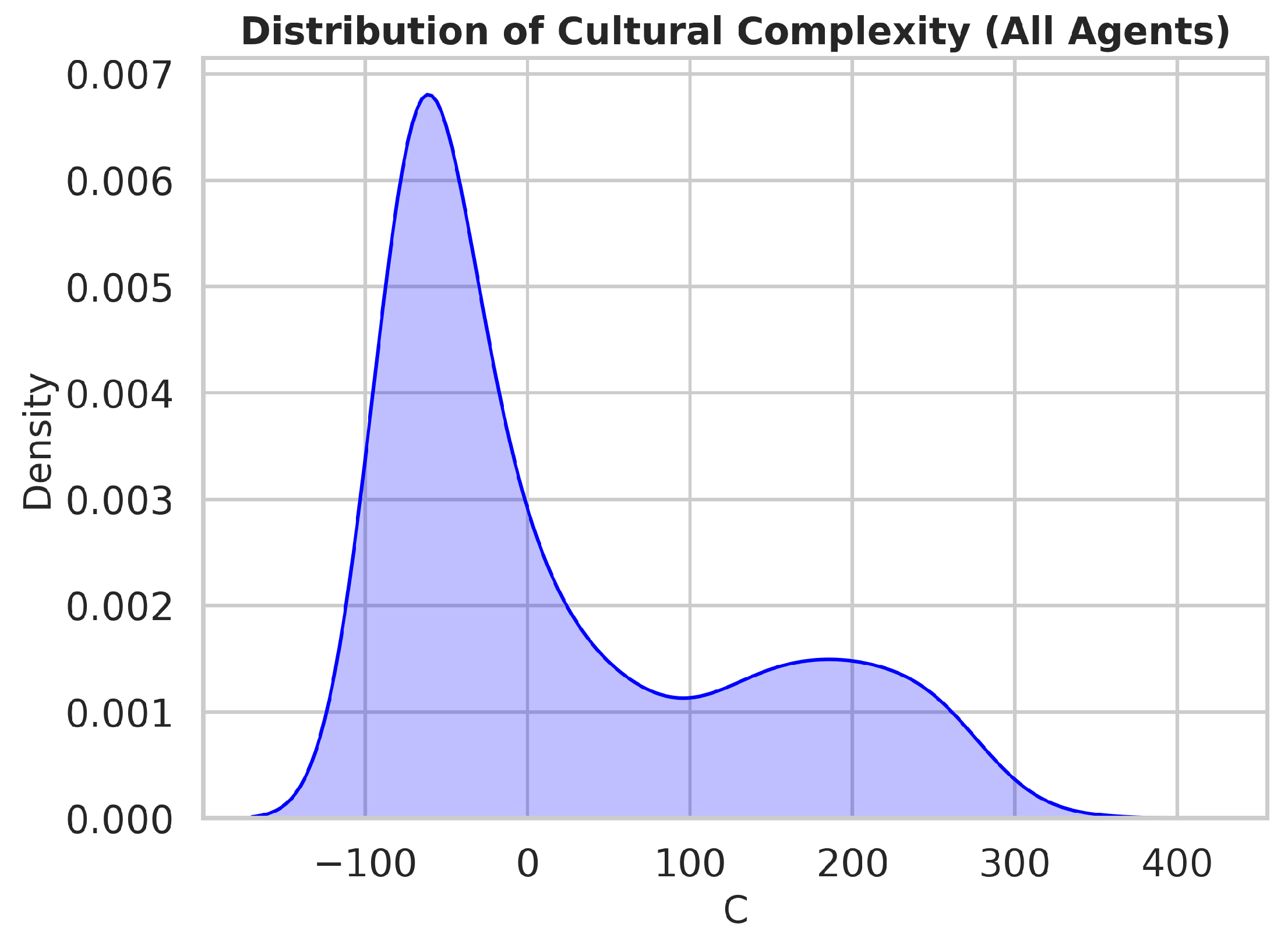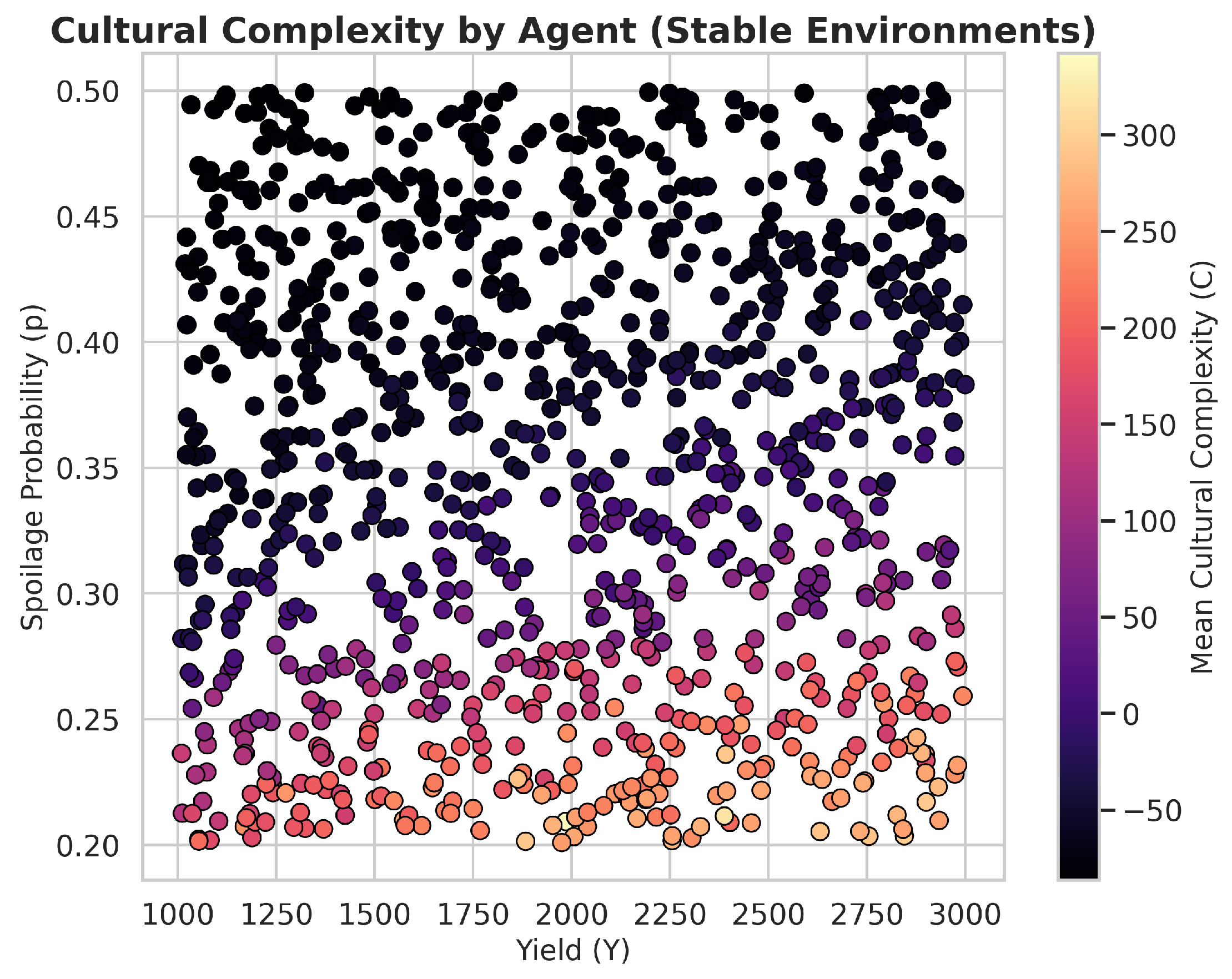Does Low Spoilage Under Cold Conditions Foster Cultural Complexity During the Foraging Era?—Agent-Based Modeling and Reinforcement-Learning Approach
Abstract
1. Introduction
2. Methods
2.1. Model Setup
- 1.
- Hunt: Costs days (e.g., ). The group consumes daily rations during these days. After completing the hunt, they obtain an effective yield proportional to Y, adjusted by the group’s management skill G and cultural complexity C. The effective yield is
- 2.
- Invest (resource management): Costs day. Improves G by a fixed increment .
- 3.
- Culture: Costs day. Increases C by a unit and grants a small immediate reward.
2.2. Propositions and Theorem
2.3. Additional Clarifications of Key Assumptions
3. Experiments
3.1. Simulation Procedure
3.2. Parameter Settings
3.3. Data Collection and Analysis
3.4. Reinforcement-Learning Setting
- Stored food level normalized by the annual requirement .
- Resource management skill level G.
- Cultural complexity C.
- The fraction of remaining time .
- Normalized yield and spoilage probability p. Here, 3000 served as a convenient normalization factor that corresponded to our maximum yield in the experimental range (). Normalizing the yield helped stabilize the agent’s input scale for learning.
- Hunt: Occupied days, with each incurring daily consumption and spoilage. After completing the hunt, the agent obtained units of food.
- Invest: Took 1 day. Improved G by a fixed increment . Daily consumption and spoilage was applied.
- Culture: Took 1 day. Increased C by 1 and gave a small immediate reward. Daily consumption and spoilage was applied.
3.4.1. RL Model and Optimization
3.4.2. Training Details
3.4.3. Parameter Variations
3.4.4. Pseudocode for Agent Decision Algorithm
| Algorithm 1 Daily Agent Decision Pseudocode |
|
4. Results
4.1. Overall Patterns
4.2. Statistical Relationships
5. Discussion
6. Conclusions
Funding
Institutional Review Board Statement
Data Availability Statement
Acknowledgments
Conflicts of Interest
References
- Epstein, J.M.; Axtell, R. Growing Artificial Societies: Social Science from the Bottom Up; Brookings Institution Press: Washington, DC, USA, 1996. [Google Scholar]
- Akopov, A.S.; Beklaryan, L.A. An agent model of crowd behavior in emergencies. Autom. Remote Control 2015, 76, 1817–1827. [Google Scholar] [CrossRef]
- Burdukiewicz, J.M. The origin of symbolic behavior of Middle Palaeolithic humans: Recent controversies. Quat. Int. 2014, 326, 398–405. [Google Scholar] [CrossRef]
- Chase, P.G. On symbols and the Palaeolithic. Curr. Anthropol. 1994, 35, 627–629. [Google Scholar] [CrossRef]
- Sterelny, K. Foragers and their tools: Risk, technology and complexity. Top. Cogn. Sci. 2021, 13, 728–749. [Google Scholar] [CrossRef] [PubMed]
- Ll, A.N.O. Cognition, behavioral modernity, and the archaeological record of the Middle and Early Upper Paleolithic. Evol. Mind Brain Cult. 2013, 5, 235. [Google Scholar]
- Wollstonecroft, M.M. Investigating the role of food processing in human evolution: A niche construction approach. Archaeol. Anthropol. Sci. 2011, 3, 141–150. [Google Scholar] [CrossRef]
- Bradley, R. The Past in Prehistoric Societies; Routledge: London, UK, 2014. [Google Scholar]
- Cook, S.E. Examining Our Past Relationship with Climate to Understand Climate’s Current Importance: An Exploration of Climate Change During the Little Ice Age. OKH J. Anthropol. Ethnogr. Anal. Through Eyes Christ. Faith 2020, 4, 52–64. [Google Scholar] [CrossRef]
- Clark, A.E.; Ranlett, S.; Stiner, M.C. Domestic spaces as crucibles of Paleolithic culture: An archaeological perspective. J. Hum. Evol. 2022, 172, 103266. [Google Scholar] [CrossRef] [PubMed]
- Apicella, C.L.; Marlowe, F.W.; Fowler, J.H.; Christakis, N.A. Social networks and cooperation in hunter-gatherers. Nature 2012, 481, 497–501. [Google Scholar] [CrossRef] [PubMed]
- Kelly, R.L. The Lifeways of Hunter-Gatherers: The Foraging Spectrum; Cambridge University Press: Cambridge, UK, 2013. [Google Scholar]
- Richerson, P.J.; Boyd, R. Not by Genes Alone: How Culture Transformed Human Evolution; University of Chicago Press: Chicago, IL, USA, 2008. [Google Scholar]
- Henrich, J. The Secret of Our Success: How Culture is Driving Human Evolution, Domesticating Our Species, and Making Us Smarter; Princeton University Press: Princeton, NJ, USA, 2016. [Google Scholar]
- Zeder, M.A. The broad spectrum revolution at 40: Resource diversity, intensification, and an alternative to optimal foraging explanations. J. Anthropol. Archaeol. 2012, 31, 241–264. [Google Scholar] [CrossRef]
- Smith, B.D. General patterns of niche construction and the management of ‘wild’plant and animal resources by small-scale pre-industrial societies. Philos. Trans. R. Soc. B Biol. Sci. 2011, 366, 836–848. [Google Scholar] [CrossRef] [PubMed]
- Mosavi, A.; Faghan, Y.; Ghamisi, P.; Duan, P.; Ardabili, S.F.; Salwana, E.; Band, S.S. Comprehensive review of deep reinforcement learning methods and applications in economics. Mathematics 2020, 8, 1640. [Google Scholar] [CrossRef]
- Souchleris, K.; Sidiropoulos, G.K.; Papakostas, G.A. Reinforcement learning in game industry—Review, prospects and challenges. Appl. Sci. 2023, 13, 2443. [Google Scholar] [CrossRef]
- Abideen, A.Z.; Sundram, V.P.K.; Pyeman, J.; Othman, A.K.; Sorooshian, S. Digital twin integrated reinforced learning in supply chain and logistics. Logistics 2021, 5, 84. [Google Scholar] [CrossRef]
- Gamble, C. Origins and Revolutions: Human Identity in Earliest Prehistory; Cambridge University Press: Cambridge, UK, 2007. [Google Scholar]
- Mithen, S. The prehistory of the mind. Camb. Archaeol. J. 1997, 7, 269. [Google Scholar]
- Shennan, S. Pattern and Process in Cultural Evolution; University of California Press: Berkeley, CA, USA, 2009; Number 2. [Google Scholar]
- Klein, R.G. The Human Career: Human Biological and Cultural Origins; University of Chicago Press: Chicago, IL, USA, 2009. [Google Scholar]
- d’Errico, F.; Henshilwood, C.S. The origin of symbolically mediated behaviour. In Homo Symbolicus: The Dawn of Language, Imagination and Spirituality; John Benjamins Publishing Company: Amsterdam, The Netherlands, 2011; pp. 49–74. [Google Scholar]
- Boyd, R.; Richerson, P.J. Culture and the Evolutionary Process; University of Chicago Press: Chicago, IL, USA, 1988. [Google Scholar]
- Laland, K.N. Darwin’s Unfinished Symphony: How Culture Made the Human Mind; Princeton University Press: Princeton, NJ, USA, 2017. [Google Scholar]
- Maryanski, A. The secret of the hominin mind: An evolutionary story. In Handbook of Neurosociology; Springer: Berlin/Heidelberg, Germany, 2013; pp. 257–287. [Google Scholar]
- Powell, A.; Shennan, S.; Thomas, M.G. Late Pleistocene demography and the appearance of modern human behavior. Science 2009, 324, 1298–1301. [Google Scholar] [CrossRef] [PubMed]
- Wrangham, R. Catching Fire: How Cooking Made Us Human; Basic Books: New York, NY, USA, 2009. [Google Scholar]
- Prentice, R. Cultural responses to climate change in the Holocene. Anthós 2009, 1, 3. [Google Scholar] [CrossRef][Green Version]
- Clarke, D.L. Analytical archaeology; Columbia University Press: New York, NY, USA, 1978. [Google Scholar]
- Bettinger, R.L.; Garvey, R.; Tushingham, S. Hunter-Gatherers: Archaeological and Evolutionary Theory; Springer: Berlin/Heidelberg, Germany, 2015. [Google Scholar]




| Parameter | Coefficient | p-Value | StdErr |
|---|---|---|---|
| const | 347.45 | <0.000001 | 7.50 |
| Y (x1) | 0.0370 | <0.000001 | 0.0024 |
| p (x2) | −1134.83 | <0.000001 | 16.23 |
Disclaimer/Publisher’s Note: The statements, opinions and data contained in all publications are solely those of the individual author(s) and contributor(s) and not of MDPI and/or the editor(s). MDPI and/or the editor(s) disclaim responsibility for any injury to people or property resulting from any ideas, methods, instructions or products referred to in the content. |
© 2025 by the author. Licensee MDPI, Basel, Switzerland. This article is an open access article distributed under the terms and conditions of the Creative Commons Attribution (CC BY) license (https://creativecommons.org/licenses/by/4.0/).
Share and Cite
Lee, M. Does Low Spoilage Under Cold Conditions Foster Cultural Complexity During the Foraging Era?—Agent-Based Modeling and Reinforcement-Learning Approach. Big Data Cogn. Comput. 2025, 9, 34. https://doi.org/10.3390/bdcc9020034
Lee M. Does Low Spoilage Under Cold Conditions Foster Cultural Complexity During the Foraging Era?—Agent-Based Modeling and Reinforcement-Learning Approach. Big Data and Cognitive Computing. 2025; 9(2):34. https://doi.org/10.3390/bdcc9020034
Chicago/Turabian StyleLee, Minhyeok. 2025. "Does Low Spoilage Under Cold Conditions Foster Cultural Complexity During the Foraging Era?—Agent-Based Modeling and Reinforcement-Learning Approach" Big Data and Cognitive Computing 9, no. 2: 34. https://doi.org/10.3390/bdcc9020034
APA StyleLee, M. (2025). Does Low Spoilage Under Cold Conditions Foster Cultural Complexity During the Foraging Era?—Agent-Based Modeling and Reinforcement-Learning Approach. Big Data and Cognitive Computing, 9(2), 34. https://doi.org/10.3390/bdcc9020034








